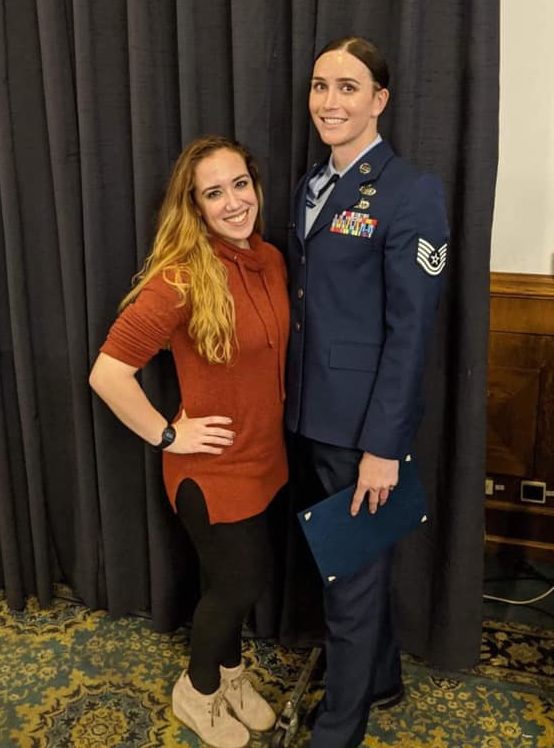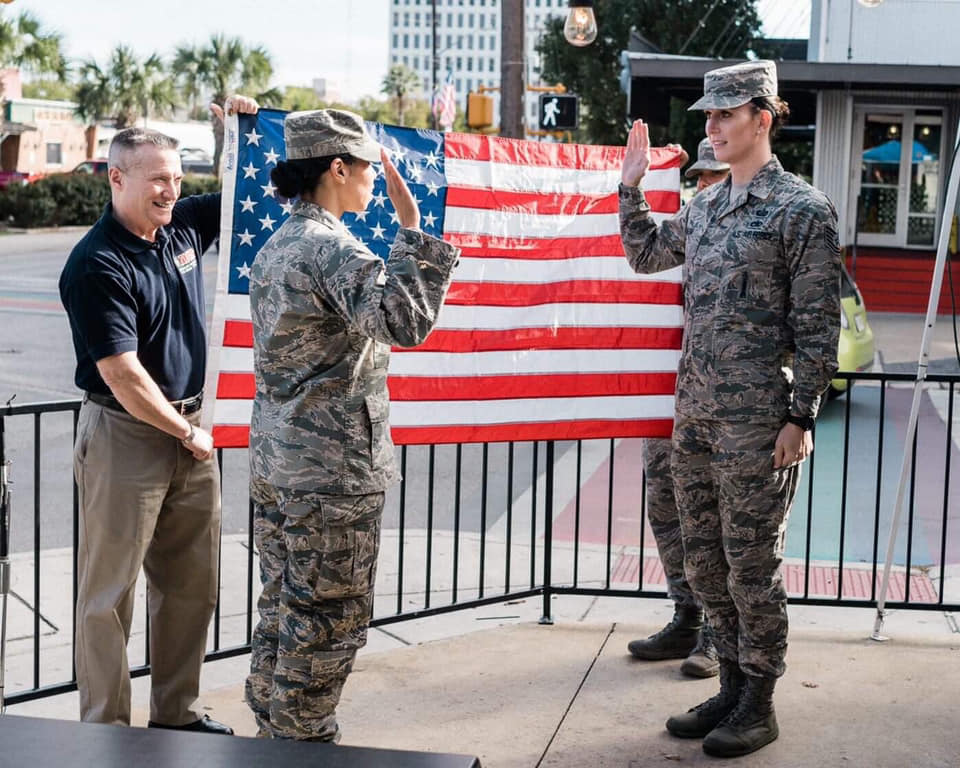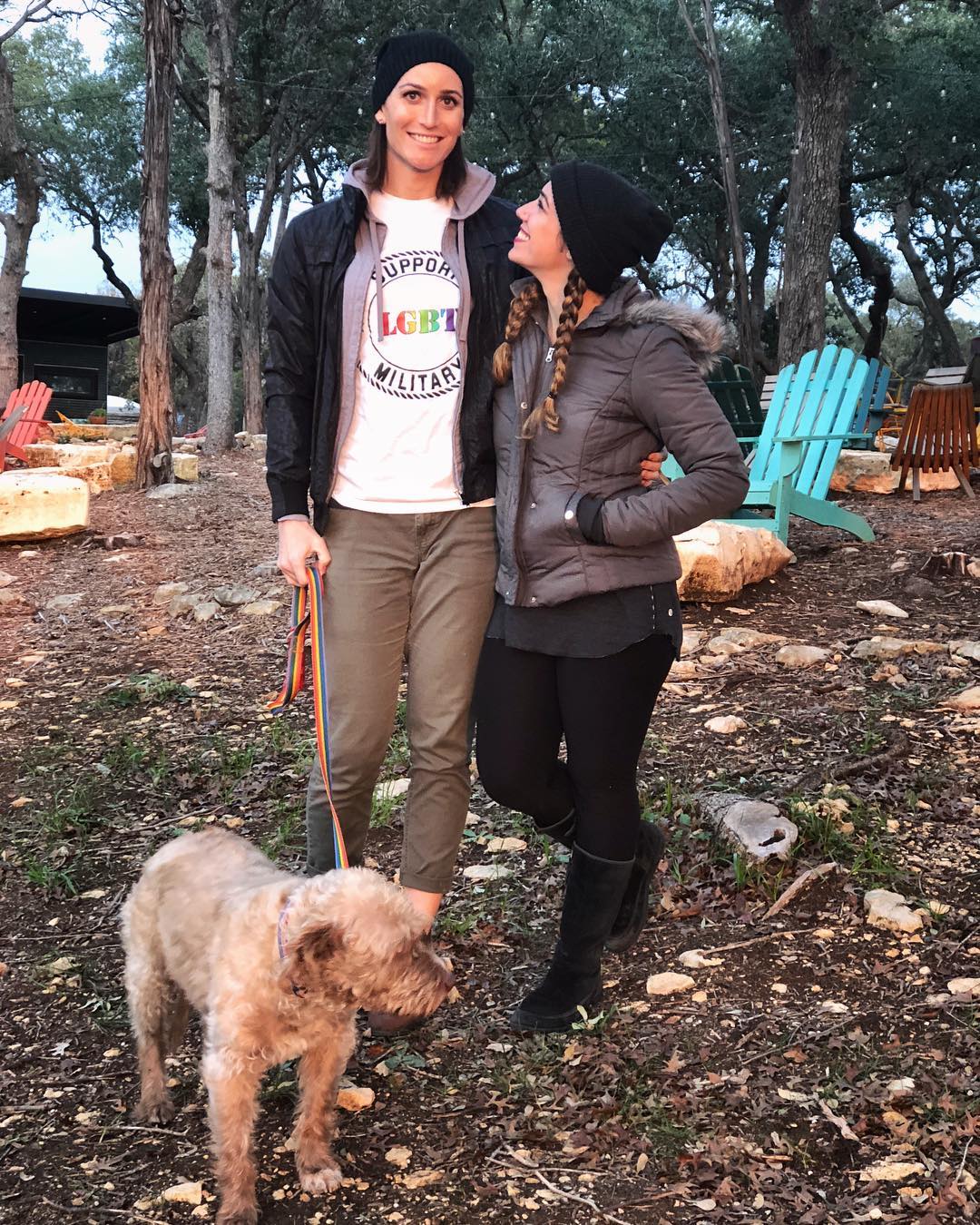LGBTQ Military Families Have Won Victories, But Still Have Big Fights Ahead
June 29, 2020Emily Starbuck Gerson is an MFAN Advisory Board member and the partner of an Air Force service member stationed in England. Emily is an award-winning freelance journalist and runs the LGBTQ blog Profiles in Pride.
On June 23, MFAN released findings from the 2019 Military Family Support Programming Survey. It covered a wide range of topics that impact the health and wellbeing of diverse, modern, military and veteran families. It included questions for the LGBTQ community, and we asked all respondents about transgender service.
The results were clear: nearly half of LGBTQ respondents did not feel supported by the military. On the flip side, when all respondents, regardless of sexual identity or gender orientation, were asked “What are your thoughts on transgender troops serving in the military?” 57.8% say they are supportive of transgender service. There is a disconnect. Especially between ages — over 73% of 20-somethings support trans service, while only about 36% of people aged 60 or older do.
Among the findings, the barriers to accessing support services were the inability to find existing support, stigma, and fear. LGBTQ+ respondents said they would like to see more local support systems available, increased health care coverage, more acceptance within military units, and more formal LGBTQ+ military organizations.
In this blog post, MFAN Advisory Board member Emily Starbuck Gerson shares her story in her own words as Pride Month winds to a close.

I wish my identity as a bisexual woman wasn’t seen as making a statement. I wish my partner’s identity as a transgender woman — especially one in the Air Force — wasn’t deemed political. Our gender identity and sexual orientation are inextricable parts of our beings, as innate as our eye color. It isn’t a choice, a mental illness, or a deficiency. While society has started to understand this and LGBTQ rights have gained momentum, there’s still a long way to go to achieve equality — especially for those in the military community.
When President Clinton signed the controversial “Don’t Ask, Don’t Tell” policy into law in 1993, it technically allowed gay, lesbian, and bisexual people to serve for the first time. But these troops had to keep their identities secret or face discharge (and transgender people were still banned). Proponents wrongly claimed open service would be a distraction and harm unit cohesion and readiness.
Forcing troops to compartmentalize a huge part of their identity took a toll. In 2011, the Obama administration repealed DADT, though in the 17 years it was in place, over 13,000 troops were discharged. Gay, lesbian, and bisexual people could finally serve authentically, but trans people — who were viewed as having a mental illness — were left out.
Trans troops left behind
When I met my partner Jamie several years ago in San Antonio, she had recently come to terms with her identity. She knew she was trans since early childhood, which is common, but she didn’t want to be different. She suppressed and denied these feelings, trying to be as masculine as possible. She joined the Air Force in 2011 to serve her country and be part of something bigger than herself, though she also hoped pouring herself into military life would keep those painful feelings at bay.
While Jamie excelled in her military career, those feelings persisted and she suffered in silence. In her late twenties, a deployment in the Middle East gave her clarity, and she returned eager to come out. But the trans ban stood in the way, so Jamie faced a difficult decision: continue serving in the closet while fearing being discovered and discharged, or give up her beloved military career and separate when her commitment ended so she could live authentically.
We gained hope upon hearing that President Obama’s Secretary of Defense Ash Carter formed a working group to assess the impact of allowing open trans service. And we felt ecstatic when the findings were in our favor and the trans ban would lift in June 2016. Jamie could continue serving and finally become the person on the outside who she’d always been on the inside. Others like her who were already serving could come out and get treatment to transition, and starting in 2018, transgender recruits could enlist.
Serving for those who can’t

Jamie has always been an exceptional Airman. She was promoted below the zone or the first time eligible for every rank, and she consistently won awards for her performance. She started her career working on the weapons systems of fighter jets, and she spent a deployment loading munitions in the Joint Coalition Against ISIS. She retrained to become a manpower analyst soon before we met, where she again excelled and won numerous awards.
So, when Jamie began to transition, I knew it wouldn’t affect her performance negatively, though she quickly proved it. She continued earning awards, and I saw how much happier and outgoing she became as she no longer fought an internal battle. Her vulnerability and bravery caused numerous Airmen to confide in her about their own struggles. Airmen who were LGBTQ or had LGBTQ kids came to her for support. Her transition actually resulted in greater unit cohesion.
She was tapped to give transgender awareness trainings to hundreds of Airmen. People often came up to her after, saying they’d never knowingly met a trans person before and she’d changed their mind on trans service.
Our world came crashing down the following summer in July 2017, when the president announced via Twitter that trans people would no longer be allowed to serve. Trans troops were previously told it was safe to step out of the closet, and many like Jamie did so — and then they were told they would get kicked out for it. We were distraught, unsure how this would impact her future. Would she be discharged and lose her salary and medical benefits tomorrow?
The reasons used to justify a new ban were similar to those used for DADT, and they were all debunked. Military leadership condemned the reversal, and Jamie’s leadership continued to support her. But we spent almost a year riddled with anxiety, trying to follow frequent and confusing developments as the policy was formed and contested in courtrooms nationwide. We didn’t know how it would affect Jamie, but she was determined to keep serving until she was told otherwise, though she now felt added pressure from being under scrutiny and wanting to work even harder to prove she deserved to be there.
The following spring, in May, then-Secretary of Defense James Mattis issued the new policy requested by the president. Jamie got lucky — she would be grandfathered in since she started transitioning under the previous administration. During this time, Jamie needed to decide whether to re-enlist. I’ll be honest: I encouraged her not to. I honored her desire to serve, but I asked why she’d want to remain part of an organization that didn’t support her and her sacrifices. But in her infinite wisdom, she said it wasn’t just about her anymore.
If the ban remained, Jamie would belong to a finite group who came out during the small permissible window. She wanted to be living proof that trans people are fully capable and serve for those who could no longer could. She re-enlisted for another six years during Transgender Awareness Week, next to San Antonio’s rainbow crosswalk. Holding the flag next to her was our friend Danny Ingram, an Army veteran who was one of the first troops discharged under DADT in 1994.

Soon after Jamie re-enlisted, she was promoted to Technical Sergeant her first time eligible. She was also sent to the Pentagon to brief a general — something rarely asked of an E-6. He was so impressed with her innovative data modeling on a manpower study, he asked her to return for a follow-up. Her identity never came up; it was a non-issue. While she was in DC, news hit that the policy won the legal victory needed to move forward. We still weren’t sure how it would impact Jamie.
Finally, the new policy was solidified and implemented last year. With only a month’s notice, it gave troops a cut-off; they had until April 12, to come forward. But it required a diagnosis of gender dysphoria from a mental health provider, which can be difficult. If troops couldn’t obtain it in time, they could never transition to serve authentically. (Per the policy, you can’t get kicked out for saying you identify as trans, but you must serve in your sex assigned at birth.) Additionally, no trans person could enlist or commission after that if they had already taken any steps to transition. It feels like another DADT.
It was a scramble. We know of troops who missed the cutoff because they were deployed, the military doctor wasn’t supportive and wouldn’t give the diagnosis (this happened to Jamie early on), or the doctor required multiple appointments and wouldn’t do it fast enough. Some peoples’ doctors weren’t available or couldn’t process the paperwork in time. We know troops who were in the early phases of coming out but not ready to start transitioning, and it forced their hand to decide.
Where we stand
The trans service ban is still in place. Jamie is one of the few allowed to serve in the military, and she continues to try to prove her worth. In September, as she wrapped up her master’s degree and we said goodbye to San Antonio, her commander awarded her a Meritorious Service Medal — a commendation very rarely given to her rank. This winter she attended the Noncommissioned Officer Academy in Germany, and out of nearly 150 Airmen, she was awarded the prestigious John Levitow Award, the highest honor for an NCOA graduate.

We’re still not totally in the clear, and the stigma and consequences of the second ban continue to impact us. It has impaired Jamie’s access to medical care; some PCMs have outright refused to see her. Her gender identity was used as a reason to deny us this assignment to England (she won on appeal, but we know others who weren’t so lucky). With no new trans troops serving, the military no longer requires transgender awareness trainings or medical education for military doctors, leaving a gap in basic support and information. The implemented policy is vague and we worry it could still be used to discharge Jamie at some point, even indirectly, or prevent her from commissioning eventually since it bans accessions for transgender people.
It’s also vital to remember that LGBTQ military families still lack many other basic rights. Only on June 15 this year did the Supreme Court finally rule that employment discrimination against LGBTQ people was illegal. But LGBTQ people still lack federal protection against discrimination in housing, health care, adoption, business service, and more (only some states ban this).
Military families already have enough stressors and battles to prepare for. Worrying about having basic equal rights while serving your country should not be one of them. Diversity makes society and the military stronger. Even once Pride Month ends, I urge you to support and advocate for LGBTQ military families — especially people of color, who struggle with another layer of discrimination.
Not sure where to start? Talk to us about our experiences. Watch the documentary Transmilitary about trans troops and look at MFAN’s new data. Speak up when you hear disparaging or inaccurate remarks. Get involved with organizations like SPART*A and Modern Military Association of America. Contact your representatives and vote. Thank you for letting me share my story.